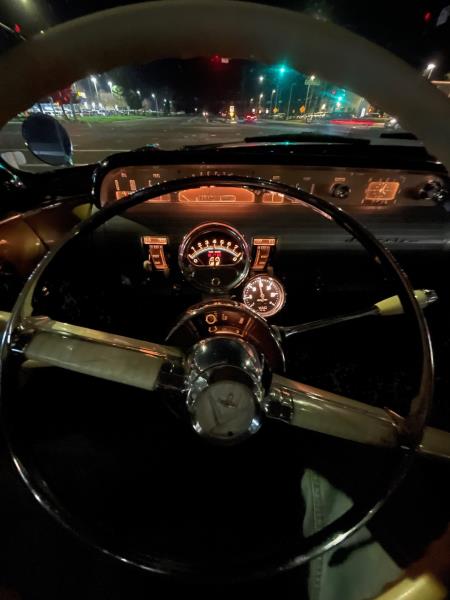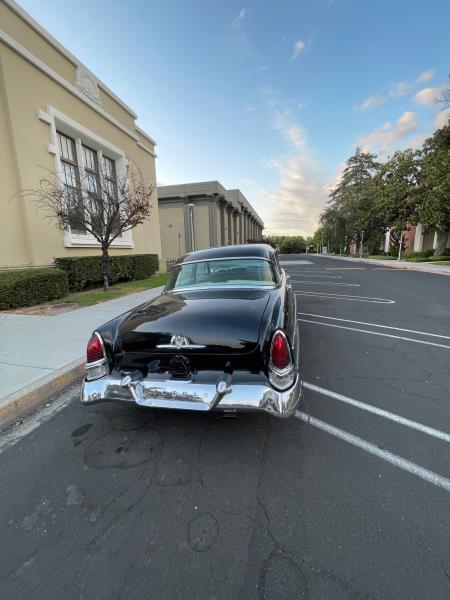|
Author
|
Message
|
|
WYEDelta
|
 Posted 2 Years Ago
Posted 2 Years Ago
|
|
Group: Forum Members
Last Active: Last Year
Posts: 31,
Visits: 15.3K
|
In the spirit of trying to improve the Street performance of the old gal I invested in a 6V Tach (positive ground naturally) and Vacuum Gauge. These instruments provide additional insight beyond the timing light and feeler gauges. A new speedometer cable is on its way to complete the cluster (unless 6V O2 sensors exist?). I was surprised to learn that the vacuum is 15" at 450 rpm while in neutral. The Lincoln shop manual calls for 18"-21" @450rpm. Anyone have a similar bone-stock Y block achieving at least 18-19" idle vacuum? My engine also draws 16.5" @ 2100 and 14-15" @2800rpm. Do these numbers sound reasonable? I gave the engine a once over in search of a vacuum leak with a tightening wrench, screwdriver and starter fluid but found nothing obvious.   ![]()
|
|
|
|
|
KULTULZ
|
|
|
Group: Forum Members
Last Active: 2 Weeks Ago
Posts: 1.8K,
Visits: 306.3K
|
|
|
|
|
|
WYEDelta
|
|
|
Group: Forum Members
Last Active: Last Year
Posts: 31,
Visits: 15.3K
|
Thanks for posting that article --definitely contains good "rules of thumb."
In my case the engine idles "fairly" steady between 14.5"-15.0" @450 rpm --500 rpm. The engine purportedly was recently rebuilt (not under my ownership) so I sure hope the rings aren't bad.
There are a couple of smoking guns I'm going after next. The first one being the spark plugs ceramics look very old for a recently refreshed engine. I can't imagine someone screwing old spark plugs into a refreshed engine but that's what I see. I'm going to pull a couple of plugs and inspect.
The other problem I have is the engine stumbles as I gently accelerate past 3000 rpm. It dare not push it to 3500 rpm because of how bad it gets. Again, maybe this is related to the spark plugs? Or is the 2140 Teapot acting up?? I'll start with the plugs and see where that leads.
Ideally I'd like to resolve this low vacuum issue and establish a baseline performance understanding BEFORE switching the fuel and ignition system from the current 2140 + Loadmatic Dizzy over to a Edelbrock AVS2 500cfm with '57 Dizzy solution (different thread).
|
|
|
|
|
Deyomatic
|
|
|
Group: Forum Members
Last Active: Yesterday
Posts: 294,
Visits: 2.4K
|
Are you sure that your total timing is set correctly? Can you describe this stumble above 3000 RPMs? Does it happen once, or does it keep skipping every second or two until you back off?
I don't think I'd be too worried about 15" of vacuum. I had an engine that couldn't make more than 11 at idle...granted it had a lopey cam...
The idle circuit in the carb is tied to the vacuum- one method of setting idle mixture is to use the vacuum gauge and turn the mixture screws until you get the highest reading. Maybe fiddle with those a bit to see if the reading goes up?
|
|
|
|
|
WYEDelta
|
|
|
Group: Forum Members
Last Active: Last Year
Posts: 31,
Visits: 15.3K
|
The stumble begins at 3000 rpm and progressively becomes more pronounced as I push the pedal more. I back off at about 3300rpm as the engine grows unhappy. Skipping and surging also sounds about right (stumbling). But it cruises OK at 2800 rpm although I do begin to sense "faint hesitations."
I used another vacuum gauge to set the idle screws as you describe above. Both screws are providing best vacuum (14.4-15") when backed out about 7/8 of turn out. BTW, the engine does die (sputters to a stop) if either screw is tightened down to 1/2 turn off stop.
Indeed, the total timing might be off. I set the initial timing back to the book's spec of 3 BDC (I had been running it at 10 BDC) . When rev'ing while in Park (no load), the timing light on the new crank timing tape shows a total of 27 degrees at 2200 rpm. As you guys know the Loadmatic doesn't have centrifugal advance so no additional timing with higher rpms. However, who knows what is happening to the total timing while under load? In this regard the Loadmatic is a black box of sorts.
You're right the 15" idle isn't end of the world territory but I'd sure be happier closer to the 18" minimum the book cites...
|
|
|
|
|
miker
|
|
|
Group: Forum Members
Last Active: Last Week
Posts: 1.9K,
Visits: 194.9K
|
I’m not familiar with the Lincoln, but Fords initial advance on the FYB is really conservative. I wouldn’t be afraid to go back and try it at 10 initial. If it pings, back it down a little and try again.
Old plugs could very well be laying down, or the wires if they’re old. I’ve also had misses develop like that from old fuel. Didn’t look or smell bad, but fresh fuel cured the problem. I blame that on the ethanol. My modern cars (I poured it in since it looked clean) burned it no problem.
Got any idea how many miles it went since the “refresh” and how long it was laid up? If it was re ringed with the old iron rings they might not have even been broken in. Or they could be lightly stuck and some miles will improve that.
miker
55 bird, 32 cabrio F code
Kent, WA
Tucson, AZ
|
|
|
|
|
WYEDelta
|
|
|
Group: Forum Members
Last Active: Last Year
Posts: 31,
Visits: 15.3K
|
Plug wires look brand new unlike the discolored porcelain plugs. Getting at the plugs to change them is a real bear. Makes me wonder if a guy, say the builder, used the old plugs to simply protect the heads and keep critters out, and later, a second guy, installed the exhausts before checking the condition of the plugs. Weird things like this can happen especially in a case such as this one, wherein the fellow I bought the car from said the engine had finally been reassembled about a year ago after sitting in a machine shop, post machining, for 8-10 years.
Long story short I'm breaking in the engine and debugging it...I've put about 600 miles on it thus far (changed the original break in oil at 75 miles). All sorts of fun issues have popped up along the way. The low vacuum is the latest. Maybe the rings haven't completely set after 600 miles ---probably stretching wishful thinking? The engine has hydraulic lifters ---maybe they're still a bit lazy?
BTW, the engine slightly ping'd at 10 BTC initial when shifting from 2-3 rd. It wasn't rattling can bad, probably will go back towards 10, but wanted to rule out a wrong initial timing as the cause of low vacuum.
Another note --- the idle set screw is completely backed off in order to acheive the idle 450 rpm. I'm also considering removing the Teapot (again) and checking the secondary throttle plates. The book calls for a 0.004" clearance using a 3/16" wide shim gauge. Maybe the secondaries are open too much and contributing to the low vacuum?
More tuning fun and games. Trying to stick to the, "Make one change at a time, test, think and then adjust," which an old timer finally ingrained my thickness with moons ago.
|
|
|
|
|
KULTULZ
|
|
|
Group: Forum Members
Last Active: 2 Weeks Ago
Posts: 1.8K,
Visits: 306.3K
|
Here is another TECH ARTICLE that may help - Cranking Vacuum & Speed Tests - https://www.motor.com/magazinepdfs/082001_05.pdfIf there was a vacuum leak, the needle would be bouncing. I would pull the plugs first and read them. If junk install fresh plugs. The low steady reading to me indicates possibly low compression (how long did the rebuild sit - frozen rings?) (cyls leak-down test), ignition and/or valve timing. It might be a good idea to use a piston stop the verify the balancer index markings are correct (and DIST is installed correctly). If not, have the balancer rebuilt and if still cannot find true TDC check cam timing. You have tip-in hesitation at mid-range, I would suspect a DIST calibrated incorrectly (does the ADV CANISTER hold vacuum?) or an accelerator pump defect/mis-adjusted (or worse yet if the TV linkage is not adjusted correctly) (does that period HYDRAMATIC use a manual TV?). I have no idea if there is someone that can go through and calibrate a LOM DIST (DIST MACHINE w/ MANOMETER). Good quality points and are adjusted correctly? The tension on the points has to be correct as this is a part of the LOM advance design. GEN is charging correctly and have a good BATT? She needs good electric to run correctly.
____________________________
|
|
|
|
|
WYEDelta
|
|
|
Group: Forum Members
Last Active: Last Year
Posts: 31,
Visits: 15.3K
|
The vacuum is definitely steady but apparently low @ 15" /450rpm. I have no way of telling how long the machined engine sat before complete assembly and fire-up but antidotally it could be up to 7-8 years. Based on the excellent feedback I'm getting here from you guys (TY), it's dawning on me I'd better run compression tests while tackling changing out the spark plugs (kill two birds). Before installing a new 7" timing tape on the Harmonic Balancer (MSD 1" wide white tape with graduations upto 60 degrees BTD), I turned Cyl #1 to TDC, verified the cam lobes were on TDC, and the pointer aligned perfectly with the HB's 0 degree mark. Several timing light rounds later I'm 99% sure the HB is in good shape. Funny you included the HydraMatic setup article. This was the very first issue I ran into. While embarking on the maiden voyage around the block, I immediately became aware that the TV lever was maladjusted. The car shifted thru all 1-2, 2-3, 3-4 before 10mph! That setting would have rendered the tranny toast in a hurry. I'm confident this gem is now shifting correctly. I happen to be partial to the early Dual Range HydraMatics, it's one of the main reasons I bought this particular year and model Lincoln the clincher being the 317 "Y" of course!.... ; -)     .
|
|
|
|
|
Hoosier Hurricane
|
|
|
Group: Moderators
Last Active: Yesterday
Posts: 3.7K,
Visits: 323.2K
|
You say that the high speed stumble starts at 3000 and gets worse by 3500. Old Lincolns had relatively soft valve springs, and with age they could be even softer. You may be experiencing valve float or lifter "pump up" . Just another thought to muddy your diagnoses.
John - "The Hoosier Hurricane"

|
|
|
|